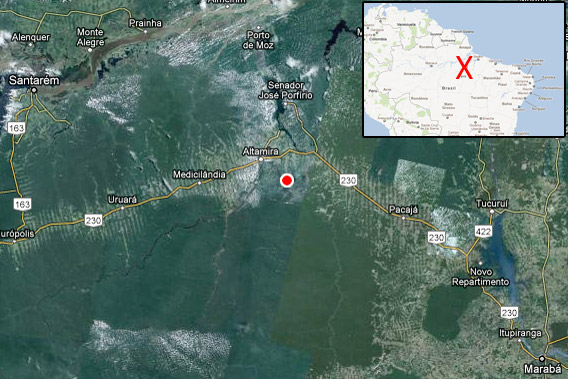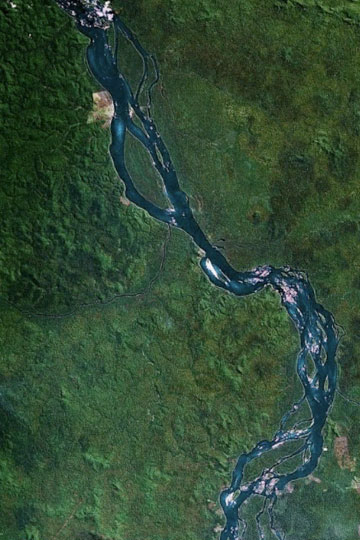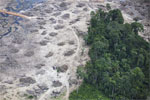
Belo Monte location. Courtesy of Google Earth.
After occupying the construction site of the massive Belo Monte dam for 21 days, some 300 indigenous people have left and gone home. The representatives from nine Amazonian tribes abandoned their occupation after two days of meeting with the dam’s builder, the Norte Energia consortium.
Belo Monte, if completed, will be the world’s third largest dam, but has been opposed by indigenous groups and conservationists for decades. The dam will displace 16,000 people according to the Brazilian government, though critics say the number is more likely 40,000. Rerouting 80 percent of the flow of the Xingu River, the dam will change the freshwater ecosystems on which a number of indigenous tribes and local communities depend and could push several species to extinction.
Despite the end of the occupation, Amazon Watch, an NGO working against the Belo Monte, says negotiations with Norte Energia were anything but satisfactory.
 A section of the Xingu River as viewed by Google Earth. |
“The talks failed to address the key demands of indigenous peoples relating to access to navigate the river around the dam, loss of fish and livelihoods, land demarcation, health and education programs, among others. During the talks with each ethnic group, Norte Energia offered each community a package of ‘trinkets’ such as TVs, boats, cameras, and computers while refusing to commit to a timetable for meeting the legally required social and environmental conditions,” says Amazon Watch in a press release.
Amazon Watch reports that the occupation was abandoned when it was announced the Xikrin people were leaving.
“Other indigenous groups decided that without the Xikrin warriors, they would end the occupation and seek other avenues of claiming their rights,” the group writes. A third meeting between Norte Energia and the indigenous is scheduled for next week.
The Brazilian government has argued it needs the $11 billion dam for power generation, but its impacts on indigenous people and the environment, including flooding pristine rainforest, have made it among the world’s most controversial hydroelectric projects. Last year, over half a million people worldwide signed a letter protesting the dam.
Related articles
Indigenous leaders demand suspension of Belo Monte dam
(07/10/2012) Indigenous leaders from six Amazon tribes have asked the Brazilian government to immediately suspend the installation license for the controversial Belo Monte dam, reports Amazon Watch, an activist group that is campaigning against the project.
Brazil’s environmental leadership at risk, warn scientists
(06/26/2012) The Brazilian government is putting its global environmental leadership at risk by ignoring scientific concern on large infrastructure projects and changes in the country’s forest laws, warned an association of more than 1,200 tropical scientists gathering last week in Bonito, Brazil on the heels of the disappointing Rio+20 Earth Summit.
Photo: Human canvas on Rio beach protests Brazil’s dam-building spree in the Amazon
(06/20/2012) Nearly 1500 people formed a human banner on a beach in Rio de Janeiro today to protest plans to build dozens of dams in the Amazon basin, reports Amazon Watch, an NGO campaigning against Brazil’s controversial Belo Monte dam.
Protesters dig canal through Belo Monte dam in Brazil (Photos)
(06/16/2012) In an symbolic protest of the giant Belo Monte Dam, Friday morning some 300 locals dug a channel in an earthen dam that blocks a portion of the Xingu River and serves as the first step of the controversial hydroelectric project, reports Amazon Watch.
Tropical dams are a false solution to climate change
(05/27/2012) Tropical dams emit considerably more greenhouse gas emissions than their temperate counterparts yet are being treated as a solution to climate change, warns a report published in Nature Climate Change.
Protesters hit Brazilian mining giant Vale over involvement in Belo Monte
(04/20/2012) More than 150 demonstrators protested outside Vale’s headquarters in Rio de Janeiro during the Brazilian mining giant’s annual shareholder meeting over the company’s social and environmental record, reports Amazon Watch, a group that is fighting the massive Belo Monte dam.
Will mega-dams destroy the Amazon?

(04/18/2012) More than 150 new dams planned across the Amazon basin could significantly disrupt the ecological connectivity of the Amazon River to the Andes with substantial impacts for fish populations, nutrient cycling, and the health of Earth’s largest rainforest, warns a comprehensive study published in the journal PLoS ONE. Scouring public data and submitting information requests to governments, researchers Matt Finer of Save America’s Forests and Clinton Jenkins of North Carolina State University documented plans for new dams in Bolivia, Brazil, Colombia, Ecuador, and Peru.
Pictures: Destruction of the Amazon’s Xingu River begins for Belo Monte Dam

(04/18/2012) The Xingu River will never be the same. Construction of Belo Monte Dam has begun in the Brazilian Amazon, as shown by these photos taken by Greenpeace, some of the first images of the hugely controversial project. Indigenous groups have opposed the dam vigorously for decades, fearing that it will upend their way of life. Environmentalists warn that the impacts of the dam—deforestation, methane emissions, and an irreparable changes to the Xingu River’s ecosystem—far outweigh any benefits. The dam, which would be the world’s third largest, is expected to displace 16,000 people according to the government, though some NGOs put the number at 40,000. The dam will flood over 40,000 hectares of pristine rainforest, an area nearly seven times the size of Manhattan.







